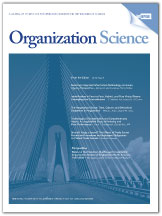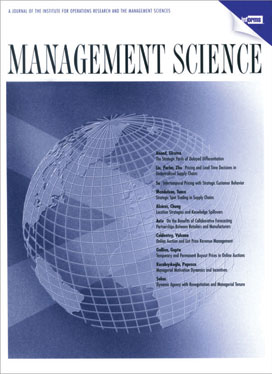Academic articles
Practitioner articles
Working papers
Books
Book chapters
Case studies
Other publications
Subject(s)
Strategy and general management; Technology, R&D management
Keyword(s)
collaboration, innovation, user, communities, online
Users often interact and help each other solve problems in communities, but few scholars have explored how these relationships provide opportunities to innovate. We analyze the extent to which people positioned within the core of a community as well as people that are cosmopolitans positioned across multiple external communities affect innovation. Using a multimethod approach, including a survey, a complete database of interactions in an online community, content coding of interactions and contributions, and 36 interviews, we specify the types of positions that have the strongest effect on innovation. Our study shows that dispositional explanations for user innovation should be complemented by a relational view that emphasizes how these communities differ from other organizations, the types of behaviors this enables, and the effects on innovation.
© 2012 INFORMS
Volume
23
Journal Pages
988–1007
Subject(s)
Economics, politics and business environment
Keyword(s)
information externality, social learning, strategic waiting, delay, information cascade
JEL Code(s)
D62, D83
We study a two-player investment game with information externalities. Necessary and sufficient conditions for a unique symmetric switching equilibrium are provided. When public news indicates that the investment opportunity is very profitable, too many types are investing early and investments should therefore be taxed. Conversely, any positive investment tax is suboptimally high if the public information is sufficiently unfavorable.
With permission of Elsevier
Volume
56
Journal Pages
1220–1240
Subject(s)
Health and environment; Human resources management/organizational behavior
Keyword(s)
age diversity, commitment, co-worker trust, nurse well-being
Nursing practice faces the challenges of succeeding with a great diversity of customers and managing a diverse workforce with a wide range of age differences. While age diversity can lead to increased creativity and a
greater richness of values and skills, it can also lead to value clashes, disrespect of each other’s viewpoints, and increased conflict. As a result, nurses frequently experience stress, work–life imbalance, and a withdrawal from commitment. We propose the injection of positive diversity mindsets (age diversity appreciation) as one
remedy. Specifically,we suggest that age diversity appreciation is positively related to nurses’ well-being (stress and work–life balance), and also positively related to their team commitment.We further hypothesize that
nurses’ trust in coworkers mediates the hypothesized relationships. Our survey data of 138 nurses in a large hospital in Germany supported our hypotheses. We discuss both theoretical and managerial implications of
our findings in the context of age diversity and nursing work outcomes in hospitals.
© 2012 Blackwell Publishing Asia Pty Ltd
Volume
14
Journal Pages
213–220
Subject(s)
Economics, politics and business environment; Ethics and social responsibility; Management sciences, decision sciences and quantitative methods; Marketing
Keyword(s)
self-control, pro-social behavior, altruism, dictator game
Volume
7
Journal Pages
304–315
Subject(s)
Strategy and general management
Keyword(s)
status, network analysis, graphs, tournaments, performance
Two competing predictions about the effect of status on performance appear in the organizational theory and sociological literatures. On the one hand, various researchers have posited that status elevates levels of performance. This line of work emphasizes tangible and intangible resources that accrue to occupants of high-status positions and thus pictures status as an asset. On the other hand, a second line of work emphasizes complacency and distraction as deleterious processes that plague occupants of high-status positions and thus portrays status as a liability. Which of these two approaches best characterizes the actual performance of individuals in a market setting? And are these views in any way reconcilable? In this article, we summarize the two views and test them in two empirical settings: the Professional Golf Association (PGA) and the National Association for Stock Car Racing (NASCAR). Using panel data on the PGA Tour, we model golfers' strokes from par in each competition as a function of their status in the sport. Using similar data on NASCAR's Winston Cup Series, we model drivers' speed in the qualifying round as a function of their status in the sport. We find curvilinear effects of status in both empirical settings. Performance improves with status-until a very high level of status is reached, after which performance wanes. This result not only concurs with the view that status brings tangible and intangible resources, but also provides empirical support for the contention that status fosters dispositions and behaviors that undermine performance.
© 2012 INFORMS
Volume
23
Journal Pages
416–433
Subject(s)
Economics, politics and business environment
Keyword(s)
Incentives, structural change, moral hazard, professional sports
JEL Code(s)
D82, J41, L14, M52
Volume
232
Journal Pages
258–278
ISSN (Online)
2366-049X
ISSN (Print)
0021–4027
Subject(s)
Economics, politics and business environment
Keyword(s)
productivity, information technologies, organizational practices, panel data
JEL Code(s)
O33, D22, D24
Volume
12
Journal Pages
1–39
Subject(s)
Economics, politics and business environment
Keyword(s)
telecommunications, access regulation, unbundling, investment
JEL Code(s)
C51, L59, L96
We provide evidence of an inherent trade-off between access regulation and investment incentives in telecommunications by using a comprehensive data set covering 70+ fixed-line operators in 20 countries over 10 years. Our econometric model accommodates: different investment incentives for incumbents and entrants; a strategic interaction of entrants' and incumbents' investments; and endogenous regulation. We find access regulation to negatively affect both total industry and individual carrier investment. Thus promoting market entry by means of regulated access undermines incentives to invest in facilities-based competition. Moreover, we find evidence of a regulatory commitment problem: higher incumbents' investments encourage provision of regulated access.
With permission of the University of Chicago Press
Volume
55
Journal Pages
189–216
Subject(s)
Economics, politics and business environment
Keyword(s)
market definition, shopping centre, externalities, characteristics approach
Volume
7
Journal Pages
421–431
Subject(s)
Strategy and general management
Keyword(s)
corporate social responsibility, competitive strategy, challenger brand, affective trust
This research builds on the complementary corporate social responsibility (CSR) literatures in strategy and marketing to provide insight into the efficacy of CSR as a challenger's competitive weapon against a market leader. Through an investigation of a real world CSR initiative, we show that the challenger can reap superior business returns among consumers who had participated in its CSR initiative, relative to those who were merely aware of the initiative. Specifically, participant consumers demonstrate the desired attitudinal and behavioral changes in favor of the challenger, regardless of their affective trust in the leader, whereas aware consumers' reactions become less favorable as their affective trust in the leader increases. Furthermore, participation, unlike mere awareness, transforms the nature of the consumer-challenger relationship from a transactional one to a communal, trust-based one.
© 2011 INFORMS
Volume
57
Journal Pages
1528–1545
ISSN (Online)
1526-5501
ISSN (Print)
0025–1909



